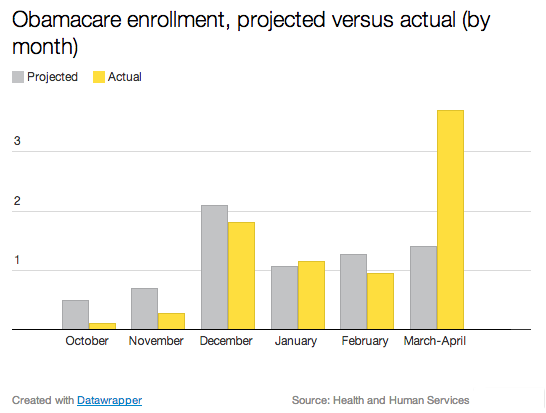Obamacare Sign Ups Hit 8 Million, Demographic Mix Falls Short of Target

President Obama took another victory lap celebrating his health care law today, announcing at an afternoon press conference that 8 million people had signed up for health coverage through the law's insurance exchanges. Obama also hammered Republicans for refusing to work with him on making needed changes to the law. The message was clear, if not exactly cogent: Obamacare is working, and the problem with the GOP is that they won't help him fix it.
It's the latest in Obamacare victory celebrations from the White House, which has taken an increasingly confident tone regarding the law in the last few weeks as sign-ups unexpectedly surged at the very end of the first open-enrollment period. I say "unexpectedly" because while the administration's own projections did foresee some increased activity in the last month, they did not anticipate the size of the spike that ended up occurring. Via Vox, here are the White House's month-to-month projections compared with actual sign-ups.

The White House's recent declarations that Obamacare is now a success have rested heavily (though not exclusively) on a single figure: the total number of sign-ups recorded. That number, of course, still doesn't tell us how many people are actually enrolled, since enrollments must be paid and 15-20 percent of people who sign-up are reportedly not paying their first month's premium (although even with a 20 percent reduction it still results in about 6.4 million enrollments). Nor does it tell us how many enrollments were previously uninsured.

Nor does the 8 million sign-ups statistic tell us the answer to what is arguably the most important figure of all: the demographic mix of sign-ups. I say arguably because, while some may differ, that is in fact what White House Press Secretary Jay Carney argued just four months ago.
"Whatever the total figure is of people who enroll by March 31st, the aggregate number," he said in early January, "the total number is not as important as the overall makeup that you see in that population."
Carney's statement came in response to a question about how many sign-ups were between the ages of 18 and 34, a demographic of younger and presumably healthier plan beneficiaries whose participation has been considered critical to the success of the law: The administration's goal, based on Congressional Budget Office estimates, was for 39 percent of the final tally to be between the ages of 18 and 34. The "worst-case scenario," according to a Kaiser Foundation analysis cited by the administration was if only 25 percent of the final tally was in that age cohort.
As it turns out, we do have information about sign-ups in that age group, and the demographic mix is much closer to the worst-case scenario than it is to the administration's target. About 28 percent of the sign-ups in the federal exchanges are between the ages of 18 and 34, according to a White House fact sheet. If, as Carney said in January, that number is much more important than the total number of sign-ups, then that's probably a bad sign for Obamacare.


Show Comments (461)